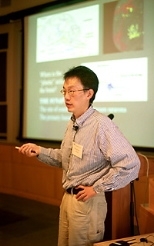Basic science will be the route to finding the cause and treatments for ailments of the brain such as Alzheimer's disease and attention deficit disorder, say experts from MIT's new brain and cognitive science research laboratories.
At one of 15 seminars held on Oct. 5 for donors and alumni, scientists from the McGovern Institute for Brain Research and the Picower Center for Learning and Memory discussed the latest discoveries about the brain's "plasticity" - the organ's ability to adapt to change, and to learn and memorize.
"The brain is plastic and changeable. The more we understand it, the more we can intervene and push it in a directed way," said Elly Nedivi, a Picower Center researcher and the Fred and Carole Middleton Assistant Professor of Neurobiology in the Department of Brain and Cognitive Sciences and the Department of Biology.
Nedivi was joined by Professor Morgan H. Sheng, a researcher at the Picower Center and the RIKEN-MIT Neuroscience Research Center, as well as by James J. DiCarlo, assistant professor of neuroscience and an investigator at the McGovern Institute for Brain Research. Dean of Science Robert J. Silbey chaired the session.
Nedivi and her colleagues are applying a new type of imaging to the brain: two-photon laser scanning microscopy, which lets her see and assess the properties of individual cells within tissues, giving a much deeper look into tissues than previously possible. The technique is used for patient imaging but had not been applied to the brain before, she said. This interdisciplinary approach is giving researchers better tools to look at changes in the brain. Eventually they hope to use computers to track movements of spines - tiny structural elements of brain cells that try to make connections with other brain cells to improve the brain's function.
"Two-photon microscopy is coming into general use in neuroscience and biology. So advances in physics and other areas are being brought to bear on areas not previously thought of," said Silbey.
The number of spines in the brain decrease with age. The same is true of other critical elements of the brain such as proteins known as AMPA receptors, which move around constantly and receive signals from brain cells. The more AMPA receptors, the stronger the connections in the brain. The brain has about 100 billion brain cells, and each can connect to between 1,000 and 10,000 partners.
"We hope in the future that we'll be able to alter the rate of change [of the AMPA receptors]," said Sheng, who is the Menicon Professor of Neuroscience in Brain and Cognitive Science in the Department of Brain and Cognitive Sciences and Department of Biology. "The microstructure and molecular organization of the brain is highly dynamic, constantly reorganizing itself, and it's 'molded' by environment and experience."
Sheng doesn't like comparisons between the brain and a computer, because "the brain does not go out of date in two to three years," he said. Instead, he likened the brain to a social organization that constantly is trying to make new synapses, or areas where a nerve impulse travels from one brain cell to another. The brain automatically knows which new connections to make, and eliminates the ones that are not effective.
In a more specific look at the brain, Dicarlo wants to understand how the brain recognizes objects, how they move, and how the response of the brain to the recognition and movement ultimately contributes to perception and behavior.
DiCarlo envisions some near-term results from his research. For example, within five years, there may be ways to develop enhanced human-like machine vision, and in 10 years there may even be artificial implants for human vision assistance and augmentation, he said.
"In 20 years, we may have molecular-based restoration of perceptual function," he said.
The researchers noted that MIT's collaborative neuroscience labs already are receiving world recognition. A new 376,000-square-foot building housing the McGovern Institute, the Picower Center, the Athinoula A. Martinos Center for Functional and Structural Biomedical Imaging, and the Department of Brain and Cognitive Sciences is to be completed by 2005.
"No place has the holistic theme that is as comprehensive as what we're trying to do," said President Charles M. Vest, who attended the session.
A version of this article appeared in MIT Tech Talk on October 9, 2002.






